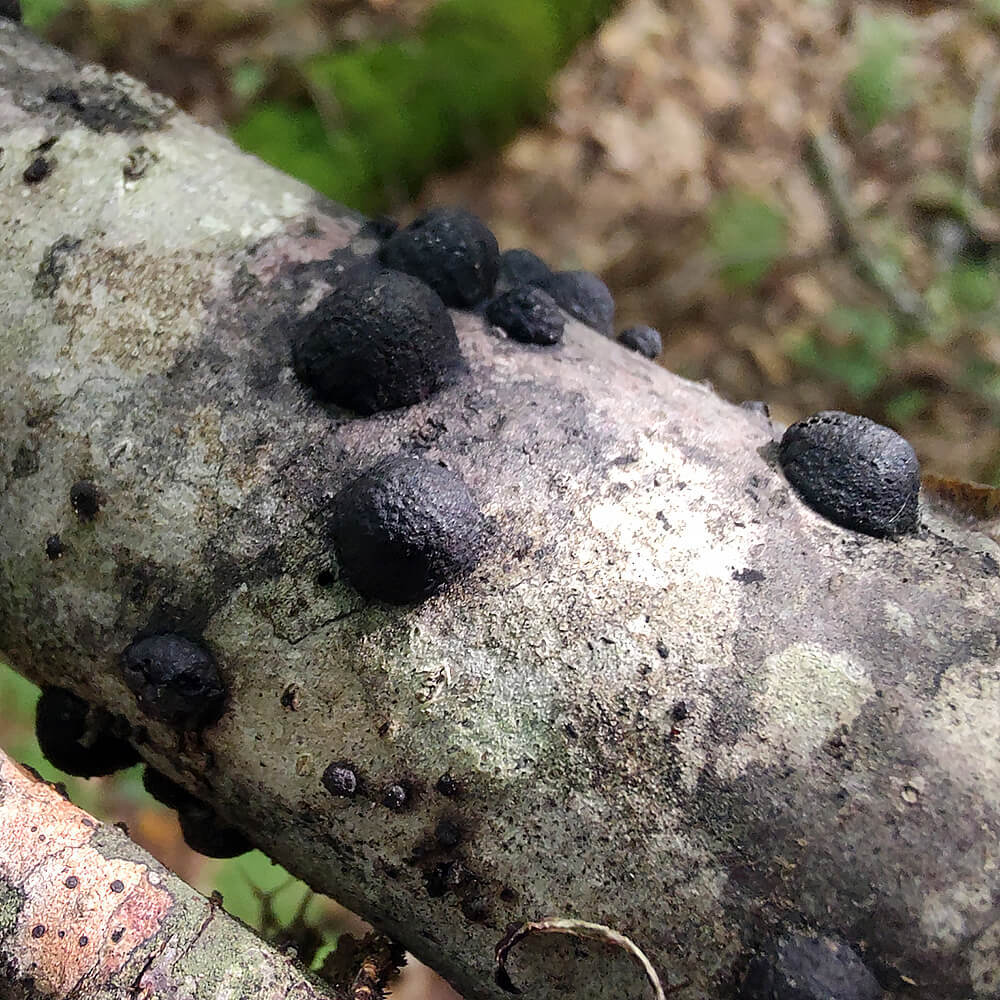Description
Black Fungus (Annulohypoxylon archeri) Liquid Culture
Bullet Points:
- Premium Liquid Culture: 12cc of high-quality, nutrient-rich liquid culture for cultivating Annulohypoxylon archeri.
- Dark, Carbon-Like Appearance: Recognized for its black, hardened stromata that resemble charred wood.
- Sterile and Pure: Produced in a sterile environment for contamination-free cultivation.
- Saprobic Fungus: Contributes to wood decay and nutrient recycling in forests.
- User-Friendly: Ideal for researchers and mycologists studying Xylariales fungi.
Taxonomic Classification:
- Kingdom: Fungi
- Division: Ascomycota
- Class: Sordariomycetes
- Order: Xylariales
- Family: Hypoxylaceae
- Genus: Annulohypoxylon
- Species: Annulohypoxylon archeri
What is the Black Fungus (Annulohypoxylon archeri)?
Annulohypoxylon archeri is a saprobic ascomycete fungus known for its hard, black fruiting bodies that resemble charred wood or carbonized material. It belongs to the Xylariales order, which includes various wood-decomposing fungi that contribute to forest nutrient cycling.
Unlike traditional mushrooms with caps and gills, Annulohypoxylon archeri forms tough, crust-like structures (stromata) on dead or dying hardwood. This species is of interest to mycologists studying fungal succession, wood decay, and secondary metabolites.
Where Does Annulohypoxylon archeri Grow?
This species is widely distributed in North America, Europe, and Asia, commonly found on fallen logs and decaying branches. It thrives in moist, shaded forest environments, fruiting year-round in humid conditions.
Due to its ability to colonize decomposing wood, it plays a role in breaking down lignin and cellulose, making it a subject of interest in fungal ecology and environmental research.
Unique Features and Research Potential
A Tough, Resilient Fungal Species
Unlike soft-fleshed mushrooms, Annulohypoxylon archeri produces hardened, dark stromata that appear rough and crusty. These structures contain tiny perithecia, which release spores for reproduction.
Potential Applications in Mycology
This species is frequently studied for its secondary metabolites, some of which have shown potential antibacterial and antifungal properties. Researchers also investigate its role in natural decomposition processes and its interactions with other fungi and microorganisms.
Sustainability and Conservation of Annulohypoxylon archeri
As a naturally occurring wood-decaying fungus, Annulohypoxylon archeri does not face significant conservation concerns. However, studying and cultivating it can provide further insight into its biological role and potential industrial applications.
This 12cc liquid culture syringe offers an exciting opportunity to study fungal succession, wood decay, and secondary metabolite production in a controlled setting.
Order Your Black Fungus Liquid Culture Today
Whether you're a fungal researcher, conservationist, or mycologist, this premium liquid culture syringe of Annulohypoxylon archeri is perfect for ecological and biochemical studies.
Description
Black Fungus (Annulohypoxylon archeri) Liquid Culture
Bullet Points:
- Premium Liquid Culture: 12cc of high-quality, nutrient-rich liquid culture for cultivating Annulohypoxylon archeri.
- Dark, Carbon-Like Appearance: Recognized for its black, hardened stromata that resemble charred wood.
- Sterile and Pure: Produced in a sterile environment for contamination-free cultivation.
- Saprobic Fungus: Contributes to wood decay and nutrient recycling in forests.
- User-Friendly: Ideal for researchers and mycologists studying Xylariales fungi.
Taxonomic Classification:
- Kingdom: Fungi
- Division: Ascomycota
- Class: Sordariomycetes
- Order: Xylariales
- Family: Hypoxylaceae
- Genus: Annulohypoxylon
- Species: Annulohypoxylon archeri
What is the Black Fungus (Annulohypoxylon archeri)?
Annulohypoxylon archeri is a saprobic ascomycete fungus known for its hard, black fruiting bodies that resemble charred wood or carbonized material. It belongs to the Xylariales order, which includes various wood-decomposing fungi that contribute to forest nutrient cycling.
Unlike traditional mushrooms with caps and gills, Annulohypoxylon archeri forms tough, crust-like structures (stromata) on dead or dying hardwood. This species is of interest to mycologists studying fungal succession, wood decay, and secondary metabolites.
Where Does Annulohypoxylon archeri Grow?
This species is widely distributed in North America, Europe, and Asia, commonly found on fallen logs and decaying branches. It thrives in moist, shaded forest environments, fruiting year-round in humid conditions.
Due to its ability to colonize decomposing wood, it plays a role in breaking down lignin and cellulose, making it a subject of interest in fungal ecology and environmental research.
Unique Features and Research Potential
A Tough, Resilient Fungal Species
Unlike soft-fleshed mushrooms, Annulohypoxylon archeri produces hardened, dark stromata that appear rough and crusty. These structures contain tiny perithecia, which release spores for reproduction.
Potential Applications in Mycology
This species is frequently studied for its secondary metabolites, some of which have shown potential antibacterial and antifungal properties. Researchers also investigate its role in natural decomposition processes and its interactions with other fungi and microorganisms.
Sustainability and Conservation of Annulohypoxylon archeri
As a naturally occurring wood-decaying fungus, Annulohypoxylon archeri does not face significant conservation concerns. However, studying and cultivating it can provide further insight into its biological role and potential industrial applications.
This 12cc liquid culture syringe offers an exciting opportunity to study fungal succession, wood decay, and secondary metabolite production in a controlled setting.
Order Your Black Fungus Liquid Culture Today
Whether you're a fungal researcher, conservationist, or mycologist, this premium liquid culture syringe of Annulohypoxylon archeri is perfect for ecological and biochemical studies.



